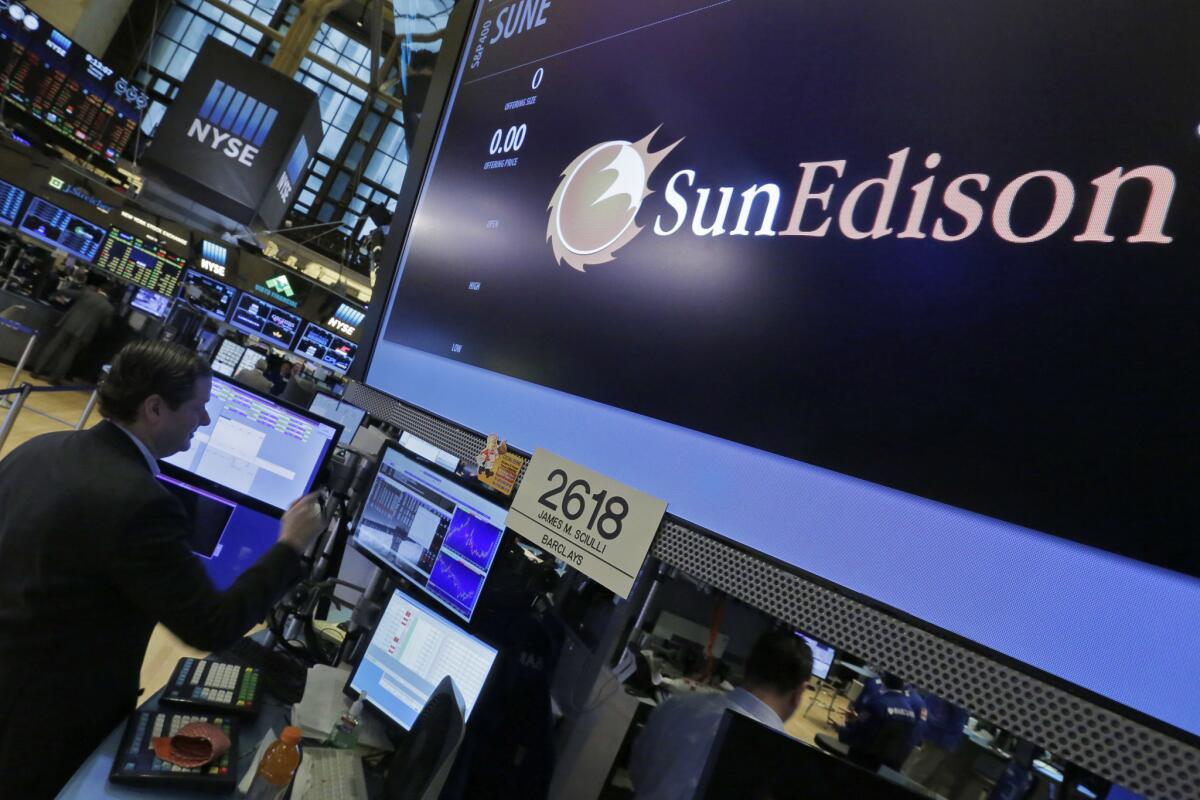SunEdison files for bankruptcy protection

SunEdison said Thursday that it is filing for Chapter 11 bankruptcy protection.
- Share via
In a spectacular collapse that took just nine months, SunEdison filed for Chapter 11 protection Thursday, marking the largest bankruptcy in the history of the renewable energy industry.
“Our decision to initiate a court-supervised restructuring was a difficult but important step to address our immediate liquidity issues,” SunEdison Chief Executive Ahmad Chatila said in a statement. “The court process will allow us to right-size our balance sheet and reduce our debt.”
In July 2015, SunEdison appeared to be riding high, building and operating commercial solar energy projects around the world, including several in Southern California. Its stock market value reached almost $10billion.
But the company, based in Missouri and with solar headquarters in San Mateo County, went on an acquisitions bender, racking up $11.7 billion in debt in the last two years. SunEdison gobbled up projects in every continent except Antarctica.
“It doesn’t work to try to be the biggest and get the biggest market share at the expense of profits,” said Jenny Chase, head of solar analysis for Bloomberg New Energy Finance. “You do have to have some focus on A) your strategic competencies and B) the bottom line.”
The company said the bankruptcy will not affect its two publicly traded subsidiaries, TerraForm Power and TerraForm Global. It said that $300 million in new financing will be used to keep up day-to-day operations such as paying vendors, delivering employee paychecks and benefits, and supplying capital for ongoing projects.
According to the Chapter 11 filing, SunEdison declared assets of $20.7 billion and liabilities of $16.1 billion as of Sept. 30.
SunEdison asked a bankruptcy judge to appoint an independent examiner to go over recent transactions, even though the company said it is unaware of any particular wrongdoing.
The company has lost more than $9 billion in equity and before trading was halted its stock was selling at 34 cents a share, down from $33.40 last July.
Last month, SunEdison revealed it is facing scrutiny from the Department of Justice and the Securities and Exchange Commission over questions surrounding its financing practices and how much cash it had on hand when its stock meltdown occurred. Given its size, the SunEdison bankruptcy figures to be complicated.
“One of SunEdison’s problems was that they had no idea what was going on within its divisions because it had so many of them,” said Chase, who is based in Zurich, Switzerland. “There’s a lot of stuff there that needs to be sorted out.”
Energy analysts say a growing number of investors worried that SunEdison’s aggressive acquisitions culture led the company to pay far more than it should have on various projects. When the stock market took a bearish turn at the end of 2015, the cost of equity went up and a vicious cycle began.
Accelerating the process was SunEdison’s embrace of “yield co” financing mechanisms. A yield co is a subsidiary that buys projects from its parent company to fuel growth, free up cash, and pay shareholders a big dividend yield.
But as capital markets got shaky, partly because of crashing oil prices, investors started taking a closer look at the quality of SunEdison’s new acquisitions and concluded the company was paying far more for the assets than it should have.
One acquisition that eventually fell apart offered a big warning sign.
Last summer, SunEdison bought Utah-based Vivint Solar for about $2.2 billion, with eyes on Vivint’s rooftop solar portfolio.
But last month Vivint terminated the deal, contending that SunEdison had failed to meet the agreement’s obligations. Vivint said it “intends to seek all legal remedies available to it in respect of such willful breach.”
“I think what we found is that management was incredibly optimistic as to how the deals that they were pulling together would pan out,” said M.J. Shiao, director of solar research for Greentech Media. “And that optimism ran counter to the market forces at large.”
Even one of SunEdison’s yield cos, TerraForm Global, turned on its parent company, filing a suit this month accusing SunEdison of failing to deliver on $231 million on projects in India.
Despite the scope of the collapse, financial analysts say SunEdison possesses a number of valuable assets that can be sold off to at least partially placate creditors.
“There are good projects here that have signed contracts in place and they
have very reasonable returns associated with them,” Shiao said. “You have a number of other developers and solar asset buyers that will be interested in taking this on, looking at these projects and perhaps taking them off of SunEdison’s hands.”
Is the news of the SunEdison collapse, coming less than a month after Spanish renewable energy giant Abengoa filed for bankruptcy in the U.S., an indication that the solar industry is in trouble?
“I definitely don’t think so,” Shiao said. “You can see some of its peers like SunPower and First Solar are profitable businesses. You can see that the industry itself is growing both within the U.S. and at a global level, and the cost of solar is falling as well.”
But critics of renewable energy subsidies say federal tax credits, which were extended for solar for an additional five years in a deal hammered out by Congress last December, should come to an end.
The U.S. Department of Energy website showed that SunEdison received $968,120 in a DOE “cooperative award” to take part in the department’s SunShot Incubator program, which has funded more than 350 projects aimed at driving down the cost of solar power.
In addition, SunEdison received grants totaling $1.87 million from the federal government’s stimulus package.
“The simple reality is that many of these companies have been dependent on financing, especially federal financing, and it means they take risks they normally would not take,” said Dan Simmons, vice president for policy at the Institute for Energy Research.
rob.nikolewski@sduniontribune.com
Twitter: @robnikolewski
Times staff writer Samantha Masunaga contributed to this report.
More to Read
Inside the business of entertainment
The Wide Shot brings you news, analysis and insights on everything from streaming wars to production — and what it all means for the future.
You may occasionally receive promotional content from the Los Angeles Times.







